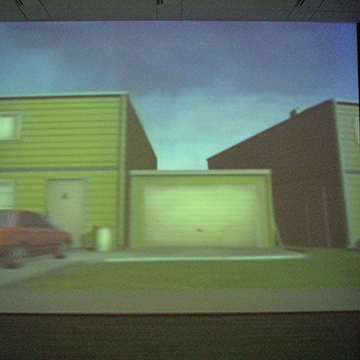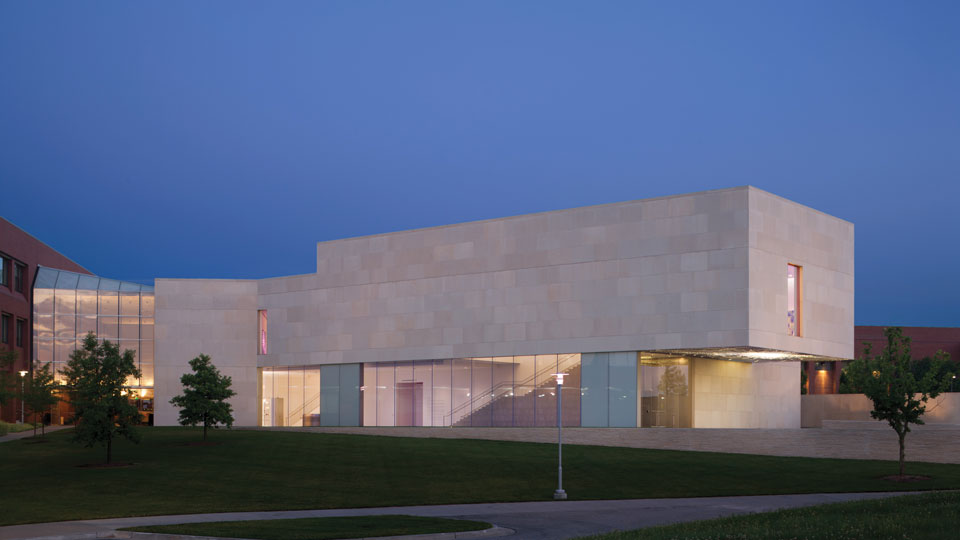Sven Pahlsson · Sprawlville
Courtesy Spencer Brownstone Gallery, New York, New York
To me the experience of the suburban world is almost unreal, and the diminishing differences between the computer-constructed virtual world and the conditions of suburban sprawl are both uncanny and frightening. Contemporary suburbia is a model virtual-reality world that we can actually live in, and it is spreading throughout the Western world. Meanwhile, with society’s rapid entry into the “information age,” virtual, electronic experiences are replacing more and more of our actual physical experiences. My most recent project, Sprawlville, examines the “American Dream” – the core of American society and culture – and the way in which it is manifested in today’s suburban spaces.
In 1956 U.S. President Dwight D. Eisenhower signed the “Federal Aid Highway Act,” paving the way for the 46,000-mile interstate highway system that connected all major American cities and made long-distance automobile transportation more effortless. The freeway system generated a new migration from the city centers to rural areas, which were transformed into new suburbs. Thanks to the initially efficient system, people were able to work in the city while living in the lush, safe countryside. But today, the ever-sprawling suburbs and the highways that connect them have rendered the city congested and dangerous. I addressed different aspects of car culture – including fear of the unpredictable and the unforeseen – in my 2001 project Crash Course.
The American Dream of owning one’s house with a lawn, pool, and three-car garage continues to fuel the growth of suburban housing developments. These projects are taking over large amounts of productive farm land at an alarming rate. Aerial maps of the spreading communities have an uncanny resemblance to medical images of diseases spreading in the human body. In suburbia there are none of the traditional common spaces for social interaction. On the contrary, it is made up of gated communities that avoid all contact with the outside world, their houses protected by security systems and shut in with blinds or curtains, “keep off” signs planted on the lawn. A functional community needs common spaces – a town square or park, for example – for meeting and interaction. In the suburbs, however, the closest thing would be the shopping mall. How people can find a high quality of life in such a repetitive, conformist community is puzzling.
The issue of safety and protection is also reflected in the strange love affair Americans have with the sport utility vehicle or SUV, a large, gas-guzzling, four-wheel-drive car. While these enormous, tanklike machines might protect the suburban family from outside dangers, they pose a threat to fellow drivers. Few SUVs are ever driven on anything other then paved highways or parking lots. Similarly artificial is the synthetic world of the shopping mall. Guarded by security personnel who keep out anything unpleasant, every suburban mall features the same chain shops and superstores with the same merchandise inside, effectively barring any possibility for individual choice. The result is total conformity, making this another completely generic space. It seems that optimistic ‘50s visions of suburban life have metamorphosed into the reality of a single, enormous, ever-growing, dysfunctional society plagued with problems like pollution and traffic jams. So why is suburbia spreading with such intensity?
Perhaps sprawl is tolerable because it has become so familiar. For me the current state of frustration and anxiety makes suburbia an interesting and relevant subject to examine. I have discovered that 3-D animation is perfectly suited to dealing with the complexity of this issue. In working with computer models, I have noticed many similarities between the world of the mall and the realm of computer-generated virtual reality. For example, the expression “big box retailer” aptly suggests the simple or nonexistent architecture of such structures, which resemble the most basic 3-D building shapes – box, cylinder, and ball. The absence of dust, dirt, or anything organic is also typical of both types of worlds. Because suburbia has become the social status quo, its familiarity seems to make it transparent to contemporary viewers. Most people – both inside and outside suburbia – seem either unaware of or already resigned to the situation. It is precisely for these reasons that Sprawlville is such an important project. It also dares to go against the grain of the few traditions of computer graphics by exploring a new kind of imagery. With the use of a more low-key output, the work creates an even higher sense of visual excitement and tension.
– Sven Pahlsson
Sven Pahlsson was born in 1965 in Lund, Sweden. He studied at the Oland Fine Art School, Sweden, and The Oslo National Academy of Arts, Norway. He lives and works in Oslo and New York.




